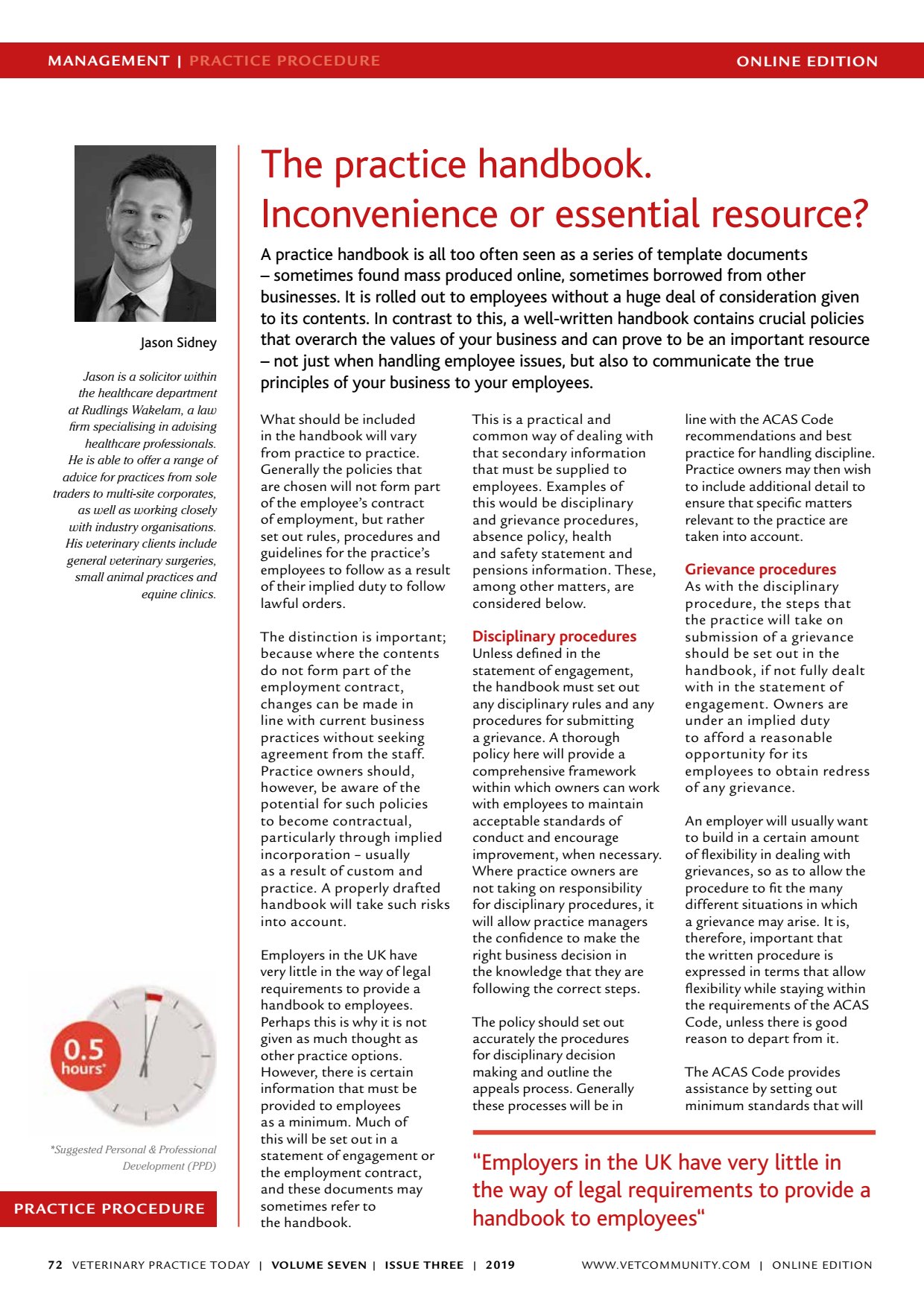Disciplinary procedures Grievance
ONLINE EDITIONMANAGEMENT | PRACTICE PROCEDURE VETERINARY PRACTICE TODAY | VOLUME SEVEN | ISSUE THREE | 2019 72 PRACTICE PROCEDURE Suggested Personal & Professional Development (PPD) Jason Sidney Jason is a solicitor within the healthcare department at Rudlings Wakelam, a law firm specialising in advising healthcare professionals. He is able to offer a range of advice for practices from sole traders to multi-site corporates, as well as working closely with industry organisations. His veterinary clients include general veterinary surgeries, small animal practices and equine clinics. The practice handbook. Inconvenience or essential resource? A practice handbook is all too often seen as a series of template documents sometimes found mass produced online, sometimes borrowed from other businesses. It is rolled out to employees without a huge deal of consideration given to its contents. In contrast to this, a well-written handbook contains crucial policies that overarch the values of your business and can prove to be an important resource not just when handling employee issues, but also to communicate the true principles of your business to your employees. What should be included in the handbook will vary from practice to practice. Generally the policies that are chosen will not form part of the employees contract of employment, but rather set out rules, procedures and guidelines for the practices employees to follow as a result of their implied duty to follow lawful orders. The distinction is important; because where the contents do not form part of the employment contract, changes can be made in line with current business practices without seeking agreement from the staff. Practice owners should, however, be aware of the potential for such policies to become contractual, particularly through implied incorporation usually as a result of custom and practice. A properly drafted handbook will take such risks into account. Employers in the UK have very little in the way of legal requirements to provide a handbook to employees. Perhaps this is why it is not given as much thought as other practice options. However, there is certain information that must be provided to employees as a minimum. Much of this will be set out in a statement of engagement or the employment contract, and these documents may sometimes refer to the handbook. This is a practical and common way of dealing with that secondary information that must be supplied to employees. Examples of this would be disciplinary and grievance procedures, absence policy, health and safety statement and pensions information. These, among other matters, are considered below. Disciplinary procedures Unless defined in the statement of engagement, the handbook must set out any disciplinary rules and any procedures for submitting a grievance. A thorough policy here will provide a comprehensive framework within which owners can work with employees to maintain acceptable standards of conduct and encourage improvement, when necessary. Where practice owners are not taking on responsibility for disciplinary procedures, it will allow practice managers the confidence to make the right business decision in the knowledge that they are following the correct steps. The policy should set out accurately the procedures for disciplinary decision making and outline the appeals process. Generally these processes will be in line with the ACAS Code recommendations and best practice for handling discipline. Practice owners may then wish to include additional detail to ensure that specific matters relevant to the practice are taken into account. Grievance procedures As with the disciplinary procedure, the steps that the practice will take on submission of a grievance should be set out in the handbook, if not fully dealt with in the statement of engagement. Owners are under an implied duty to afford a reasonable opportunity for its employees to obtain redress of any grievance. An employer will usually want to build in a certain amount of flexibility in dealing with grievances, so as to allow the procedure to fit the many different situations in which a grievance may arise. It is, therefore, important that the written procedure is expressed in terms that allow flexibility while staying within the requirements of the ACAS Code, unless there is good reason to depart from it. The ACAS Code provides assistance by setting out minimum standards that will Employers in the UK have very little in the way of legal requirements to provide a handbook to employees WWW.VETCOMMUNIT Y.COM | ONLINE EDITION
